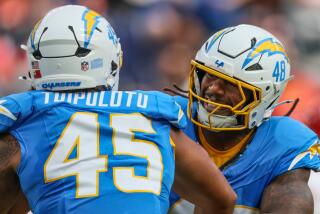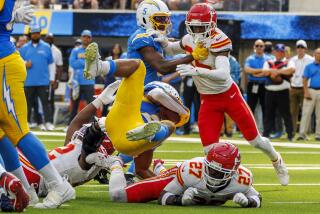Chargers Shoot for Moon Today Against Houston
SAN DIEGO — The Chargers believe they know how to stop Houston’s run-and-shoot offense today.
Chase and destroy the quarterback.
“The key to this game is if we can knock Warren Moon out of the ballgame,” safety Martin Bayless said. “It’d be over. We’d win this one. We gotta get Warren Moon out of the ballgame.”
A total Moon eclipse?
“We never go into a game with that idea of trying to hurt somebody,” defensive coordinator Ron Lynn said. “But we’d like to beat him up. We’d like to influence the fact he’s going to throw the ball in a different manner and fashion than what he’s used to.
“We’d like to take him out of the game in terms of taking him out of the rhythm of the game. We’re not interested in trying to hurt the guy, but we’d like to bang him around and we’d like to make it a physical game.”
A healthy Moon avoided the Chargers’ pass rush a year ago, threw for two touchdowns and ran for another in the Oilers’ 34-27 victory in San Diego Jack Murphy Stadium.
“Certainly if you pass more there’s more opportunities for the quarterback to get hurt,” Moon said. “But if you look at Miami and Dan Marino when he was throwing a lot, if you get rid of the football and are doing the things you are supposed to, you shouldn’t get hit that much.”
Today Moon comes back to confront the Chargers (1-2) as the trigger man in Coach Jack Pardee’s wide-open passing attack. The Oilers are also 1-2, but Moon has thrown seven touchdown passes, completed 60.4% of his passes and averaged more than 320 yards a game via the air.
“If Warren Moon can dictate the game, Warren Moon will eat you alive,” safety Vencie Glenn said. “If he knows where he wants to go with the ball, and has the opportunity to throw it, we’re in trouble.”
In Houston’s run and shoot, there’s little running. It’s shoot for the Moon on nearly every play. The Oilers have rushed the ball 48 times in three games; in contrast, the Chargers have hugged the ground on 86 occasions.
“It’s just line up and play pass,” Bayless said. “It’s a big test for the secondary, but we got some people up front who are going to cause Moon to make some bad throws. No doubt about that.
“Some of the things that we are going to do up front are going to keep him from making big plays because he can’t throw the ball with people in his face. Or if he’s lying on his back.”
The run and shoot has been criticized for making the quarterback vulnerable to injury. Although some teams rely on their tight ends to provide additional pass protection, there isn’t a tight end on the Oilers’ roster.
The lone running back in the formation may stay at home to field the blitz, but he’s also set free at times as a fifth receiver.
“The first game I took a couple of shots that made me a little sore,” Moon said, “but since then I’ve been fine. Last week I only got touched once or twice.”
Moon has completed 84 passes in three games, with Drew Hill, who has caught 20, working as his favorite receiver. Wide receiver Haywood Jeffires has 17 catches, Ernest Givens has 14 and a 17.7-yard average per catch, and Curtis Duncan also has 14 receptions.
Lorenzo White has rushed a team-high 28 times, but has averaged only 2.3 yards an effort. Last week, Allen Pinkett came in and gave Houston a boost with five runs for 37 yards in a 24-10 victory against the Colts.
“Offensively we’ve moved the ball, but we’ve been inconsistent and we’ve turned the ball over too many times,” Moon said. “The turnovers have killed us. Our defense has played well enough for us to be undefeated.
“You look at the statistics, and we’re up on top in almost everything. We’re also No. 1 in turnovers, and that wipes out everything else.”
Moon has thrown seven interceptions, and the Oilers have lost six of eight fumbles. They have also run hot and cold, having failed to score a point in the first quarter this season, and only five in the third, although striking for 28 and 27 in the second and fourth quarters respectively.
The Chargers’ defense will be without starting linebacker Billy Ray Smith, who is on injured reserve with a strained stomach muscle, nose tackle Joe Phillips, who was hurt in an off-the-field attack this week, and Glenn, who is still recovering from a concussion.
“The key to this game is going to be turnovers; we have to get them,” cornerback Gill Byrd said. “We just can’t let them stay in that run and shoot all day and move up and down the field.”
If the defense is successful in tripping the run and shoot, the offense will have its opportunity to tangle with the AFC’s No. 1 defense. The Oilers’ defense has allowed only three touchdowns.
“Nobody’s been able to run on them,” said David Richards, the Chargers’ right guard. “And their offense just eats up time. Seventy plays a game. We need to be productive on the ground; we can’t ask our defensive line to pass rush 70 times.”
The run and shoot was devised 30 years ago by Glenn (Tiger) Ellison, an Ohio high school coach. The wide-outs line up 17 yards on either side of the ball, but never closer than six yards to the sideline. The slots--or inside receivers--line up one to three yards from the tackles and one yard behind the line of scrimmage.
Each receiver has any number of pass-route options based on how he’s played by the defense. The quarterback takes “angle” drops of three, five or seven steps, rather the traditional straight-back retreat from center. The idea is to stretch the defense.
“Some people think this is a gimmick offense,” Pardee said. “It’s a sound offense. And I really don’t care if other teams want to understand it or not.”
The Chargers understand. They understand they have to get to the quarterback.
“We’re looking forward to the challenge,” Bayless said. “All the critics say the run and shoot is the offense of the ‘90s. We’ll see.”


